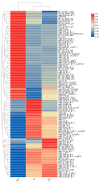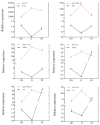Transcriptome-Wide Evaluation Characterization of microRNAs and Assessment of Their Functional Roles as Regulators of Diapause in Ostrinia furnacalis Larvae (Lepidoptera: Crambidae)
- PMID: 39336670
- PMCID: PMC11432511
- DOI: 10.3390/insects15090702
Transcriptome-Wide Evaluation Characterization of microRNAs and Assessment of Their Functional Roles as Regulators of Diapause in Ostrinia furnacalis Larvae (Lepidoptera: Crambidae)
Abstract
microRNAs (miRNAs) function as vital regulators of diapause in insects through their ability to post-transcriptionally suppress target gene expression. In this study, the miRNA of Ostrinia furnacalis, an economically important global crop pest species, was characterized. For the included analyses, 9 small RNA libraries were constructed using O. furnacalis larvae in different diapause states (non-diapause, ND; diapause, D; diapause-termination, DT). The results identified 583 total miRNAs, of which 256 had previously been identified, whereas 327 were novel. Furthermore, comparison analysis revealed that 119 and 27 miRNAs were differentially expressed in the D vs. ND and DT vs. D, respectively. Moreover, the expression patterns of their miRNAs were also analyzed. GO and KEGG analysis of the target genes of differentially expressed miRNAs highlighted the importance of these miRNAs as diapause regulators in O. furnacalis, especially through metabolic processes, endocrine processes, 20-hydroxyecdysone, and circadian clock signaling pathways. In summary, this study highlighted the involvement of specific miRNAs in the control of diapause in O. furnacalis. To the best of our knowledge, this is the first study to identify miRNA expression patterns in O. furnacalis, thereby providing reference and novel evidence enhancing our current understanding of how small RNAs influence insect diapause.
Keywords: Ostrinia furnacalis; diapause; miRNA; molecular mechanism; regulation.
Conflict of interest statement
The authors declare no competitive economic conflicts of interest.
Figures







Similar articles
-
Genome-wide analysis reveals transcriptional and translational changes during diapause of the Asian corn borer (Ostrinia furnacalis).BMC Biol. 2024 Sep 13;22(1):206. doi: 10.1186/s12915-024-02000-1. BMC Biol. 2024. PMID: 39272107 Free PMC article.
-
Identification of immunity-related genes in Ostrinia furnacalis against entomopathogenic fungi by RNA-seq analysis.PLoS One. 2014 Jan 17;9(1):e86436. doi: 10.1371/journal.pone.0086436. eCollection 2014. PLoS One. 2014. PMID: 24466095 Free PMC article.
-
Identification and functional analysis of microRNAs in the regulation of summer diapause in Galeruca daurica.Comp Biochem Physiol Part D Genomics Proteomics. 2021 Mar;37:100786. doi: 10.1016/j.cbd.2020.100786. Epub 2020 Dec 29. Comp Biochem Physiol Part D Genomics Proteomics. 2021. PMID: 33418194
-
Current understandings of olfactory molecular events in the Asian corn borer, Ostrinia furnacalis (Lepidoptera: Crambidae).Arch Insect Biochem Physiol. 2023 Apr;112(4):e21996. doi: 10.1002/arch.21996. Epub 2022 Dec 27. Arch Insect Biochem Physiol. 2023. PMID: 36575613 Review.
-
Endocrine and enzymatic shifts during insect diapause: a review of regulatory mechanisms.Front Physiol. 2025 Mar 14;16:1544198. doi: 10.3389/fphys.2025.1544198. eCollection 2025. Front Physiol. 2025. PMID: 40161974 Free PMC article. Review.
Cited by
-
Developmental Expression Patterns of miRNA in Mythimna separata Walker (Lepidotera: Noctuidae).Genes (Basel). 2025 Feb 19;16(2):234. doi: 10.3390/genes16020234. Genes (Basel). 2025. PMID: 40004562 Free PMC article.
References
Grants and funding
LinkOut - more resources
Full Text Sources

